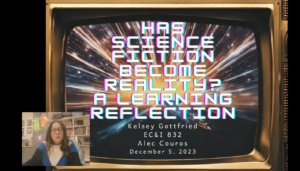According to the National Literacy Trust (2023), “[l]iteracy is the ability to read, write, speak, and listen in a way that lets us communicate effectively and make sense of the world.”
The skills and competencies identified by the National Literacy Trust (2023) are those that are already well understood as being the qualities needed to be literate– to be able to critically engage with a range of media, content, perspectives, opinions, and stories. While media and methods of communication have dramatically changed in the last few decades, the most basic competencies of reading, writing, speaking, and listening continue to apply (though those competencies might look a little different these days).
In the last couple of years, particularly with the advent of new and more accessible AI technologies, I have often found myself contemplating the direction that education and in turn, literacy development, will have to take in order to adequately prepare students to engage in digital and non-digital spaces. Often, these ponderings (and sometimes, spirals) have concluded with the same idea: that to be literate in the modern world is to be able to adapt, apply, and utilize the same general literacy competencies as have been taught for decades.
This is not to say that the bench mark for being literate is to be able to write an essay, or to be able to read an obscurely outdated written text, or to be able to give an extended formalized speech through memorization; rather, to be literate in today’s technologically driven world means to be able to decipher disinformation, to read and comprehend messaging in all forms of media, to be able to utilize the available digital tools to communicate information clearly.
In outlining the vulnerabilities faced by youth, Moyer (2022) argues that our educational systems need to actively incorporate educational programs and curricula that support students in developing the skills needed to “separate fact from fiction,” to be able to accurately identify disinformation and the biases that are apparent in much of the media that we consume through digital platforms today. There is little doubt that as media continuously evolves, that there will be an ongoing need to actively incorporate critical (media) literacy into educational practices for youths and adults alike.
In this digital age, the definition of “literate” has not changed, nor have the basic literacy competencies transformed dramatically; instead, what has been a constant transformational state has been the media and ways that information and stories are spread and shared.
When considering the ways that technology has and continues to impact our understanding literacy, I often reference the article, “Is Google Making Us Stupid?” by Nicholas Carr (2008). Though Carr’s article is 15 years out of date, the exploration of the ways that media, in this case Google and other search engines, have changed how we read and access information continues to feel quite relevant today… How are the media that we access changing the ways that we think? How is education going to adapt to the ever evolving ways that our students access information, stories, and content? What literacy competencies will be most important in the future? Which (if any) will be irrelevant?
Works Cited:
Carr, N. (2008). Is Google Making Us Stupid? The Atlantic. https://www.theatlantic.com/magazine/archive/2008/07/is-google-making-us-stupid/306868/.
Moyer, M.W. (2022). Schoolkids Are Falling Victim to Disinformation and Conspiracy Fantasies. SCIAM. https://www.scientificamerican.com/article/schoolkids-are-falling-victim-to-disinformation-and-conspiracy-fantasies/.
National Literacy Trust. (2023). What is Literacy? National Literacy Trust. https://literacytrust.org.uk/information/what-is-literacy/#:~:text=Literacy%20is%20the%20ability%20to,make%20sense%20of%20the%20world.





